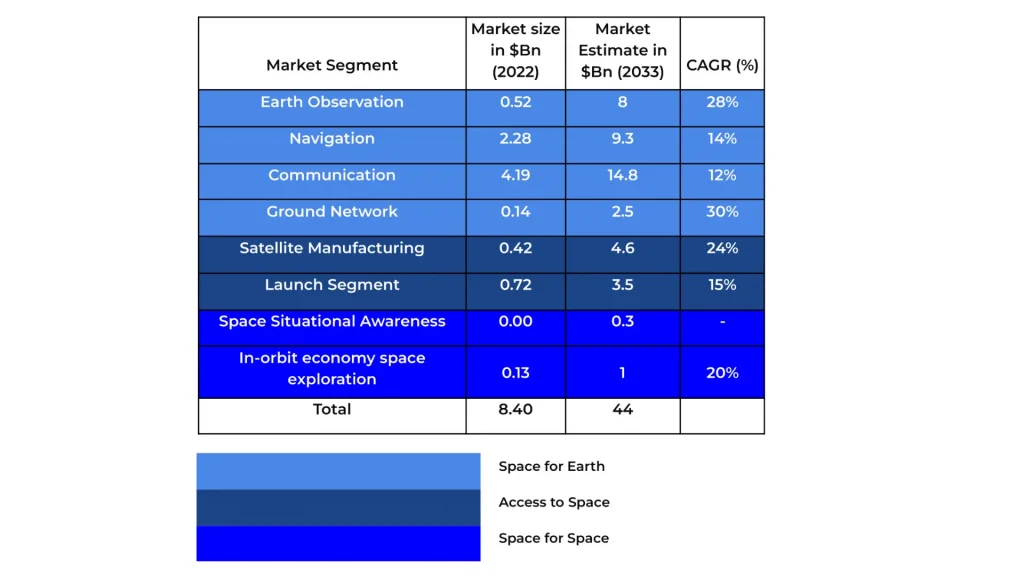Rocketing Ahead: Unveiling India’s Cosmic Quest in the Space Tech Arena
published By Siddhi Kasliwal , April 13, 2024

Do you ever find yourself marveling at the uncanny resemblance between reality and the fantastical scenarios portrayed in science fiction? If so, prepare to be captivated, for the domain of space technology is currently witnessing a convergence of visionary concepts and tangible advancements that rival even the most imaginative cinematic portrayals!
Consider this: at present, our planet is encircled by over 4500 satellites, with an estimated projection of approximately 2800 additional satellites slated for launch each year in the foreseeable future. This equates to an average of about 8 satellites launched daily—an impressive testament to humanity’s surging presence in the vast expanse of space.
While stalwart pioneers such as the United States, Russia, and China have long held dominion over the realm of space exploration, India, under the astute guidance of the Indian Space Research Organization (ISRO), has emerged as a formidable contender. ISRO’s resounding success in launching missions to celestial bodies such as the Moon and Mars has firmly established India’s position as a significant player on the global stage.
In a strategic initiative aimed at fostering private sector participation in space endeavors, the Indian government has introduced the Indian National Space Promotion and Authorization Center (IN-SPACe). Serving as a facilitator and regulatory body, IN-SPACe endeavors to empower private entities through technology transfers, financial assistance, and access to testing infrastructure—an attempt to catalyze a vibrant ecosystem of space-related enterprises.
While missions like Chandrayaan and Mangalyaan have undoubtedly captured global attention with their lunar and Martian exploits, the ascent of private enterprises within the space technology landscape heralds a new era of innovation and opportunity.
Furthermore, with the Indian space industry poised to catapult from $8.4 billion to a staggering $44 billion by 2033, the trajectory of growth appears nothing short of astronomical. This exponential surge underscores the transformative potential inherent in space-related ventures.
Space Tech Industry – Addressing every link in the chain:
The industry is delineated by IN-SPACe into key segments of: access to space, space for Earth, and space for space, as outlined below:
- Access to Space:
- This segment encompasses the development and deployment of systems necessary for reaching and operating in orbits beyond Earth.
- It includes the construction of launch infrastructure, the design and manufacture of launch vehicles, as well as the production of associated hardware and software.
- The overarching objective is to facilitate the transportation of payloads, satellites, and astronauts into space.
- Space for Earth:
- Within this segment, space assets and resources deployed in orbit are harnessed to enable a variety of applications and use cases on Earth.
- Examples include earth observation, navigation systems (such as GPS), communication systems (satellite communication), and weather forecasting.
- The focus is on leveraging space-based technologies to address terrestrial needs and challenges, thereby enhancing communication, navigation, and monitoring capabilities.
- Space for Space:
- This segment involves the development of systems and solutions aimed at enabling and sustaining operations in space itself.
- It encompasses space exploration missions for research and development purposes, the provision of in-orbit services for satellites (such as maintenance and refueling), as well as activities related to space traffic management and debris mitigation.
- The primary objective is to support ongoing exploration and utilization efforts in space, while also ensuring the safety and sustainability of activities conducted in orbit.
All these 3 segments have new age players emerging in the Indian ecosystem as mapped below (non-exhaustive):

As per the Decadal Vision unveiled by IN-SPACe in Jan ‘23, following is a view of the key growth segments within space technology:

The most prominent sectors within the space technology industry today in India are navigation and communication, both of which have become integral parts of our daily lives. Globally, companies like Starlink (a division of SpaceX), have already deployed over 6000 satellites in low Earth orbit, with projections indicating that this number could skyrocket to as many as 42000. These satellites provide internet connectivity from space to any location on Earth, a development that has profoundly transformed global communication dynamics.
Amongst the various new and emerging areas in the value chain, we foresee biggest value unlocks by private players in India happening in key areas of:
- Earth Observation:
Earth Observation is projected to become an $8 billion market by 2033, offering significant opportunities for both domestic and international markets. Despite the Indian Space Research Organization (ISRO) launching its first remote sensing satellite in 1988 and currently operating a constellation of around 44 such satellites, their commercial applications have been limited due to constraints in coverage, data capture frequency, and use cases.
However, there is a burgeoning demand for satellite data across various sectors such as maritime surveillance, forestry, border security, insurance, oil and gas, agriculture, and mining. To address this demand, numerous startups have emerged in the Indian space ecosystem, providing customized data solutions tailored to specific industries.
While optical imagery has traditionally been the primary technology for Earth observation, it is limited to capturing images only in daylight and under clear weather conditions. To overcome these limitations, new technologies like Synthetic Aperture Radar (SAR) and Hyperspectral imagery are being developed. Indian startups like Pixxel (specializing in hyperspectral imagery), Piersight (focused on SAR), and Galaxeye (offering multispectral imagery) are at the forefront of developing prototypes and solutions using these advanced technologies.
Although the scientific principles behind these innovations are well-established, the key challenge lies in demonstrating the effectiveness of hardware and software in real-world scenarios. Currently, most players in the Indian space industry are in the process of showcasing their technology through test satellites and data processing. Over the next 3-4 years, these startups are expected to launch multiple satellites, forming constellations that cover key regions of interest for their clients.
The rapid advancement of these startups and their potential to revolutionize Earth observation through space technology applications is generating excitement within the industry. The ecosystem is waiting to witness the young entrepreneurs actually showcasing their technical prowess and unlocking real commercial opportunities.
- Satellite and components manufacturing:
Satellite and components manufacturing is poised to become a USD 4.6 billion market in India by 2033. With the escalating demand for satellites for earth observation, navigation, and communication, it is crucial to enhance the upstream value chain of components and manufacturing processes. Reflecting the broader trend of indigenization across industries, particularly in space technology where defense applications hold sway, the government is steadfast in retaining intellectual property, profit pools, and as much of the value chain as possible within the country.
Key subsystems in satellite manufacturing encompass antennas, power electronics, propulsion systems, thermal control systems, sensors, and data handling units. The challenge lies in seamlessly integrating these components to cater to specific use cases while fortifying the supply chain for each. Strategic decisions regarding whether to procure or build each component significantly impact the speed of satellite deployment downstream.
The commercial viability of satellite applications hinges on hardware optimization, driving global efforts towards miniaturization. Innovative approaches include optimized mechanical structures, such as origami-based satellites pioneered by NASA. These satellites are launched in a folded state to minimize volume, subsequently unfolding in space to reduce the size of the satellite bus and lower power and fuel requirements. Additionally, there is a surge in the development of innovative materials for components, capable of withstanding the rigors of launch and space while being lightweight.
In this thriving landscape, startups like Bellatrix and Dhruva Space are emerging as key players in supplying cutting-edge components. Dhruva Space’s announcement of a sprawling 2,80,000 sq.ft. full-stack manufacturing facility in Hyderabad in October 2023 underscores the sector’s growth trajectory. Moreover, a robust network of small and medium-sized manufacturing facilities, long-standing suppliers to ISRO and aerospace clients, is witnessing blossoming partnerships with new-age funded satellite startups. These collaborations underscore the industry’s potential for innovation and growth, positioning India as a key player in the global satellite manufacturing ecosystem.
- Launch segment:
The launch segment is anticipated to grow into a USD 3.5 billion market by 2033, comprising satellite launchers and the essential infrastructure for satellite deployment into space. Across the globe, nations, including India, are intensifying efforts to fortify their launch infrastructure in response to the escalating demand for satellite launches.
Presently, there exists a substantial waiting period for satellite launches, with bookings often necessitating advanced arrangements of 6-12 months. This delay stems from the practice of launch vehicles accommodating multiple satellites or payloads, mandating meticulous capacity utilization optimization for economic viability.
Key players in this sphere include prominent entities such as Agnikul and Skyroot, actively contributing to the advancement of launch capabilities. Moreover, there is a prevailing expectation that launch vehicles will undergo miniaturization over time, facilitating streamlined and more frequent launches. This anticipated trajectory is poised to enhance space accessibility and stimulate innovation within the satellite industry.
As these segments expand, we stand on the brink of witnessing a surge in proprietary technology developed by India, benefiting both domestic needs and the global community, thus creating genuine value for all stakeholders.
It’s an opportune moment for entrepreneurs to showcase boundless innovation and cultivate groundbreaking businesses that truly transcend the limits of our world.



